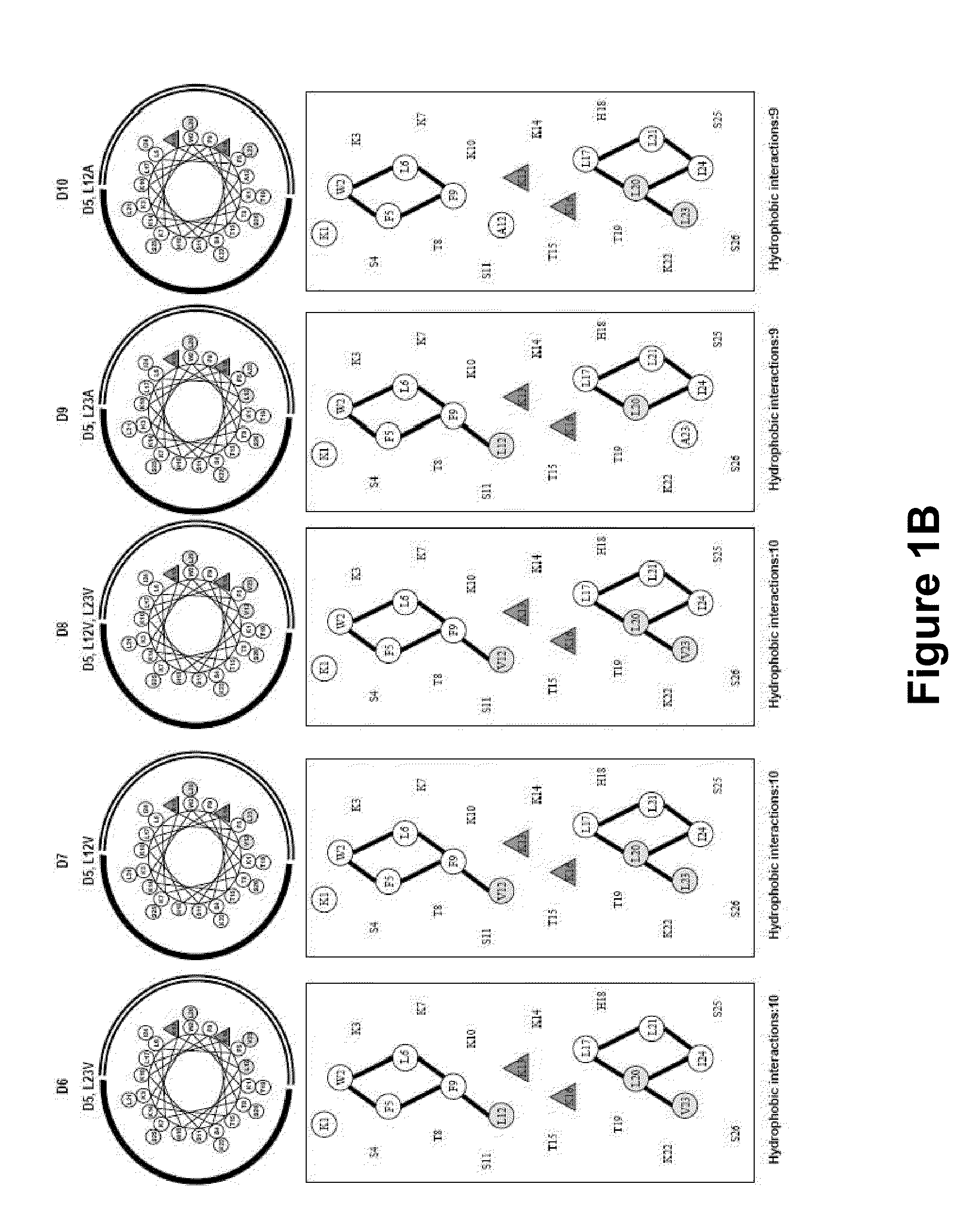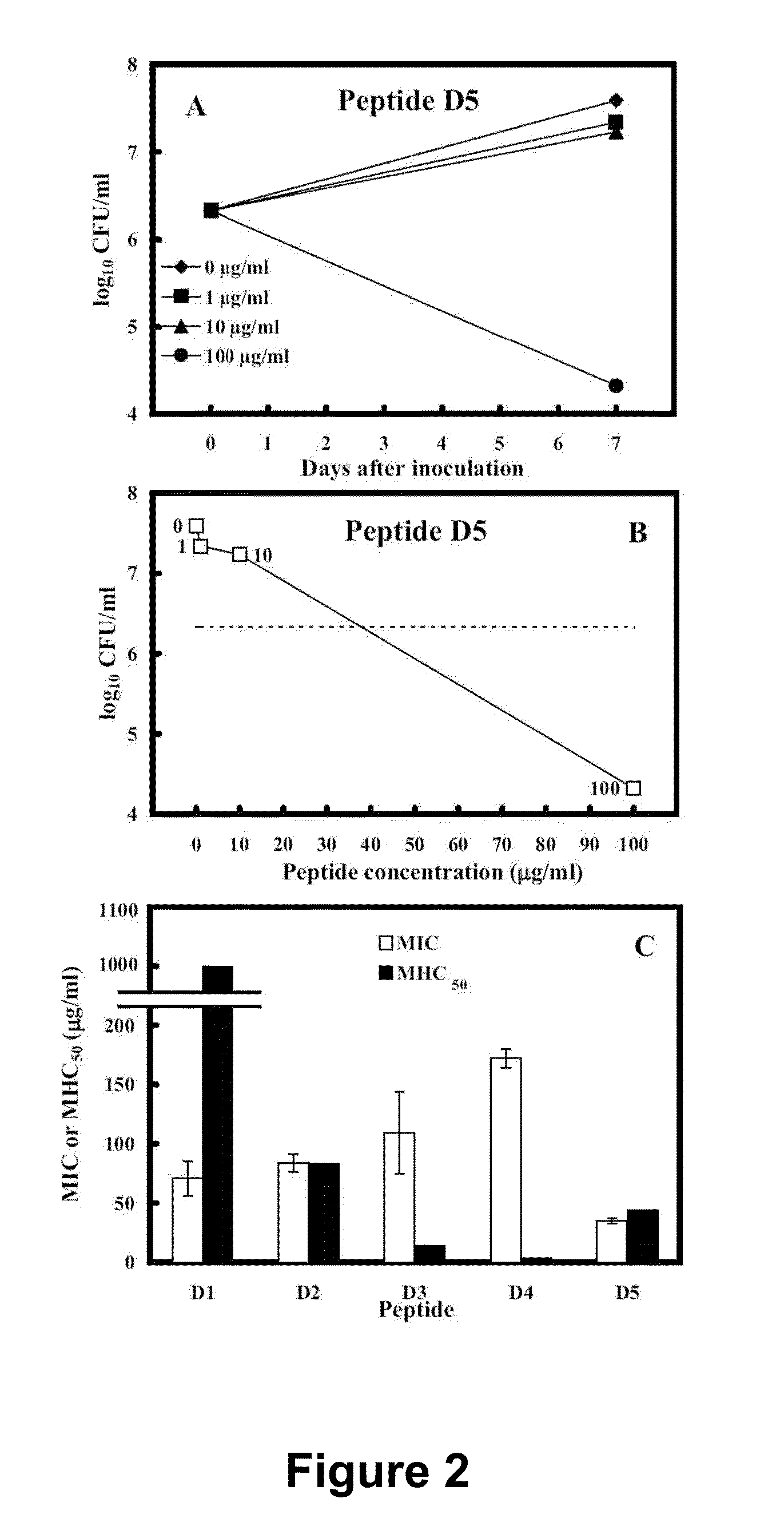Antimicrobial Peptides and Methods of Use
a technology of antimicrobial peptides and antimicrobial peptides, which is applied in the direction of antibacterial agents, peptide/protein ingredients, drug compositions, etc., can solve the problems of increasing permeability and loss of barrier function, causing toxic side effects in patients, and affecting the effect of antimicrobial peptides' ability to bind and inhibit aggregation, solubility and solubility
- Summary
- Abstract
- Description
- Claims
- Application Information
AI Technical Summary
Benefits of technology
Problems solved by technology
Method used
Image
Examples
example 1
Derivatives of Peptide V681 with Modified Activity
[0073]In previous studies, the 26-residue amphipathic antimicrobial peptide with polar and non-polar faces (28), Ac-KWKSFLKTFKS-AVKTVLHTALKAISS-amide (V681, SEQ ID NO:1) was the framework to study the effects of hydrophobicity and hydrophilicity, amphipathicity and helicity via one or more amino acid substitutions in the centers of the polar and nonpolar faces of the amphipathic helix on biological activities. D- / L-amino acid substitution sites were at the center of the hydrophobic face (position 13) and at the center of the hydrophilic face (position 11) of the helix; these substitution sites were also located in the center of the overall peptide sequence. These studies demonstrated the importance of peptide self-association; disruption of α-helical structure in benign conditions by D-amino acid substitutions or substitutions of hydrophilic / charged L-amino acids on the non-polar face can dramatically alter specificity; and these sub...
example 2
Peptide Analogs with Varied Position of Substitution
[0176]The correlation between peptide hydrophobicity and hemolytic activity can be explained by the “membrane discrimination” mechanism. Peptides with higher hydrophobicity penetrate deeper into the hydrophobic core of red blood cell membrane (67), causing stronger hemolysis by forming pores or channels, i.e., A12L / A23L (peptide 5) and A12L / A20L (peptide 6) exhibited stronger hemolytic activity than single Leu-substituted peptides, and A12UA20L / A23L (peptide 7) showed the strongest hemolytic activity in this study. For peptide antimicrobial activity, since the insertion of the molecules into the hydrophobic core is not necessary to lyse bacterial cells during the antibacterial action, peptides only lie at the interface parallel with the membrane allowing their hydrophobic surface to interact with the hydrophobic component of the lipid, and the positive charge residues to interact with the negatively charged head groups of the phosp...
example 3
Peptide Analogs with Varied Nature of Charge Substitution
[0177]Further peptides of the invention are generated by varying the nature of the charged residue selected for the substitution. In the context of D5 (SEQ ID NO:56), for example, the position for substitution is established as position 13. The amino acid selected for substitution is preferably a charged amino acid and is in particular an amino acid with a net positive charge. Particular examples of positively charged (basic) residues at positions 13 and 16 are Lys, Arg, Orn, H is, diaminobutyric acid and diaminopropionic acid. We note that Orn has a delta-amino group instead of an epsilon / □-amino group in Lys, i.e., the side-chain is shorter by one carbon atom; diaminobutyric acid is one carbon shorter than Orn; i.e., it has a gamma-amino group; diaminopropionic acid is two carbons shorter than Orn.
PUM
| Property | Measurement | Unit |
|---|---|---|
| pH | aaaaa | aaaaa |
| Time- | aaaaa | aaaaa |
| pH | aaaaa | aaaaa |
Abstract
Description
Claims
Application Information
 Login to View More
Login to View More - R&D
- Intellectual Property
- Life Sciences
- Materials
- Tech Scout
- Unparalleled Data Quality
- Higher Quality Content
- 60% Fewer Hallucinations
Browse by: Latest US Patents, China's latest patents, Technical Efficacy Thesaurus, Application Domain, Technology Topic, Popular Technical Reports.
© 2025 PatSnap. All rights reserved.Legal|Privacy policy|Modern Slavery Act Transparency Statement|Sitemap|About US| Contact US: help@patsnap.com



